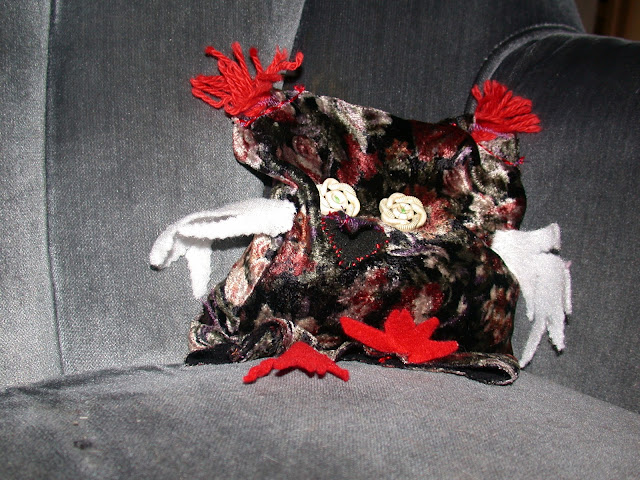I got my port removed today!
The device was surgically placed just below my collarbone back in November, prior to the start of chemotherapy. Chemo drugs are so corrosive they would burn through the smaller veins in the arm; the port allows these drugs to be infused directly onto a major artery. Here's what the port looked like while it was still in me:
And although it did allow me to communicate with the Starship Enterprise, I was nevertheless happy to be rid of the port. Its removal has symbolic importance. Some people choose to keep their ports in case they need them again in the future, but that doesn't seem like much of a vote of confidence in the immune system. Anyway, my port was sore much of the time, especially when I used my arm. Maybe it's just me, but I enjoy having pain-free use of my arm.
Rick documented today's surgery. Don't be squeamish, now!
Jan's Health Updates
Thursday, May 3, 2012
Sunday, April 15, 2012
Results of Post-Treatment PET Scan: Drum Roll, Please
I wish you could have seen my before and after shots. I asked if I could have them emailed to me, but the technology wouldn't cooperate. The PET scan I had done back in October made me look like a dalmatian, covered with black spots of cancer, along with some alarmingly large dark patches. In the repeat scan from a couple weeks ago, there is not a dot of black. My oncologist said my scan was pristine. That was the word he used: pristine.
And this is fabulous not only because it's fabulous, but because it's not necessarily what we were expecting. Many patients with my diagnosis don't get a complete remission from their treatment.
Pristine.
And this is fabulous not only because it's fabulous, but because it's not necessarily what we were expecting. Many patients with my diagnosis don't get a complete remission from their treatment.
Pristine.
Saturday, March 31, 2012
Pressure's Off
Thirty days out from my last round of chemo, my main problem now is very low blood pressure, a condition that leaves me limp like a handkerchief and for which there is no medical treatment. My home remedy is to follow the Supreme Court hearings on the Affordable Care Act. Reading about some of the absurdities transpiring there must be worth a BP boost of at least a few points, I figure.
Friday, March 30, 2012
Sting
Here's another passage from The Hobbit, this one sounding as though it refers directly to chemotherapy:
"Don't stray off the track!--if you do, it is a thousand to one you will never find it again and never get out of Mirkwood; and then I don't suppose I, or anyone else, will ever see you again."
"Do we really have to go through?" groaned the hobbit.
"Yes, you do!" said the wizard, "if you want to get to the other side."
And here's one more, which represents nicely the triumphant feeling of the patient who has successfully finished treatment:
There was the usual dim grey light of the forest-day about him when he came to his senses. The spider lay dead beside him, and his sword-blade was stained black. Somehow the killing of the giant spider . . . made a great difference to Mr. Baggins. He felt a different person, and much fiercer and bolder in spite of an empty stomach, as he wiped his sword on the grass and put it back into its sheath.
"I will give you a name," he said to it, "and I shall call you Sting."
"Don't stray off the track!--if you do, it is a thousand to one you will never find it again and never get out of Mirkwood; and then I don't suppose I, or anyone else, will ever see you again."
"Do we really have to go through?" groaned the hobbit.
"Yes, you do!" said the wizard, "if you want to get to the other side."
And here's one more, which represents nicely the triumphant feeling of the patient who has successfully finished treatment:
There was the usual dim grey light of the forest-day about him when he came to his senses. The spider lay dead beside him, and his sword-blade was stained black. Somehow the killing of the giant spider . . . made a great difference to Mr. Baggins. He felt a different person, and much fiercer and bolder in spite of an empty stomach, as he wiped his sword on the grass and put it back into its sheath.
"I will give you a name," he said to it, "and I shall call you Sting."
Tuesday, March 27, 2012
"Bother burgling and everything to do with it!"
I'm reading The Hobbit for the 10,000th time, because it constitutes a kind of literary comfort food. It makes a wonderful allegory for most any unpleasant adventure one could have, including the medical kind. Here's a bit of dialogue from the book that sounds to me exactly like the kind of advice I always get from doctors:
"Now scuttle off and come back quick if you can. If you can't, hoot twice like a barn-owl and once like a screech-owl, and we will do what we can."
"Now scuttle off and come back quick if you can. If you can't, hoot twice like a barn-owl and once like a screech-owl, and we will do what we can."
Sunday, March 25, 2012
Marching Forth
The template for the March Fourth
Marching Band could, I suppose, be said to be the marching band of
high school and college tradition. When you see March Fourth in
action, you recognize certain elements: ornamental headgear;
two-toned, button-down jackets and matching pants; batons; percussion
and brass in great numbers; team spirit.
Yet March Fourth is sort of a marching
band on acid. The 23-member ensemble travels the world in a Merry
Prankster-ish bus named Razzle Dazzle. Its sound is as much klezmer
as John Philip Sousa; in its costuming and choreography I see a
little Vaudeville, a little of the Jazz Age, a little Sergeant
Pepper's. Where a traditional marching band moves in formation, March
Fourth has stiltwalkers striding hither and thither among its
rambunctious fans, hoisting up children, dancing, performing short
comic skits. Where a traditional marching band places an emphasis on
uniformity, March Fourth's presentation is ad-libbed and libertarian.
Traditional marching bands dress their ranks and cover down their
files, while March Fourth performers are often in something of a
state of quasi-dress and un-cover, with fishnets as common as pith
helmets. A traditional marching band, for all its color and volume,
is regimented, while the carnivalesque, improvisational
March Fourth seems barely contained within a “corps”: it's a
military-style band that has exploded, leaving the air a-flutter with
confetti and sparkles.
Rick and I are lucky not only to count
ourselves among March Fourth's fans, but to have a friend in the
band, and a few weekends ago we were gifted a pair of tickets to the
band's show (on March 4th; when else?) as a chemo-is-over
celebration. We attended the matinee (the night show was past our
bedtime) among the crazy
angles, “floating” mechanical dance floor and painted plaster
faces of Portland's famous Crystal Ballroom. We sat in the balcony
with (we suspect) moms and pops of the performers. This daytime show
included a cameo by budding musicians who had attended a March Fourth
summer band camp for teenagers last year, as well as the usual
dizzying retinue of hula hoop artists, giant human marionettes and
dancers. The emphasis of the circus acts is on whimsy and exuberance
rather than acrobatic virtuosity, but make no mistake: the musicians
are top-notch, and their sound—comprised entirely of drums, horns
and electric guitars—is like nothing else you've ever heard. March
Fourth describes its own output as “a full-blown big-stage
brass-rock-funk assault peppered with moments of swing, jazz,
bollywood, ska and metal,” if you can grok that.
I am filled with wonder at the
spectacle, and have many questions for the band, like: how does one
compose music for such an ensemble? How are decisions made? (Not, I
suspect, by dictatorial fiat of a band leader—yet surely not by
consensus democracy, either—with 23 members?) Do you ship Razzle
Dazzle to Europe when you play there? And most of all, where do I
sign up for summer band camp for 47-year-olds?
At any rate, our getting to be present
in the audience that day was gift enough—so I was flabbergasted to
learn that our friend in the band had composed a song in my
honor, which debuted then and there. This is surely the only time
anyone has ever written a piece of music for me—and what piece it is! The tune
is called “Janjar.” Our friend, Taylor Aglipay, was wearing a pink sleeveless cowboy shirt for the occasion, along with an enormous piece of
headgear fashioned—I am not making this up—from the hair of a
goat in Azerbaijan. Evidently the hat still smells faintly goaty.
Thursday, March 22, 2012
A Traveling Companion
My friend Dvora uses scrap fabric to make stuffed animals she calls Binkies. Usually she makes them for foster children, but she sewed one for me. It has very soft fur, wonderful flower-button eyes and red tufts of yarn for ears.
I suppose in a sense all cancer patients are foster children. We are turned out of the bodies we've always inhabited, and we are made to live in new ones. We are entirely at the mercy of The System, which might treat us kindly, or not. The past, which--whatever it was like, was, after all, the only life we knew--is seen in a new and distinctly unfriendly light: why is this bad thing happening to me? Was it something I did? Then, too, we are afraid to attach to strongly to any particular vision of the future.
Under such circumstances, a Binky is a welcome traveling companion. Mine is quite pettable, and its bean-bag body sufficiently floppy that it would mold to my face if I wanted to sleep on it. If it came to that, I could probably suck on its tufted ears, too, though I probably won't. I do have to remain somewhat germ-conscious.
I suppose in a sense all cancer patients are foster children. We are turned out of the bodies we've always inhabited, and we are made to live in new ones. We are entirely at the mercy of The System, which might treat us kindly, or not. The past, which--whatever it was like, was, after all, the only life we knew--is seen in a new and distinctly unfriendly light: why is this bad thing happening to me? Was it something I did? Then, too, we are afraid to attach to strongly to any particular vision of the future.
Under such circumstances, a Binky is a welcome traveling companion. Mine is quite pettable, and its bean-bag body sufficiently floppy that it would mold to my face if I wanted to sleep on it. If it came to that, I could probably suck on its tufted ears, too, though I probably won't. I do have to remain somewhat germ-conscious.
Subscribe to:
Comments (Atom)









